The Sword In The Stone: Gold Classic Collection
by Ben | April 4, 2003 10:35 pm
Walt Disney Pictures (December 25 1963), Walt Disney Home Video (March 20 2001), single disc, 79 mins plus supplements, 1.33:1 original negative ratio, Dolby Digital 5.1 Surround, Rated G, Retail: $19.99
Storyboard:
Based on the 1938 novel by T.H. White (Walt Disney actually bought the rights a year later, but it took him some 20-odd years to translate the story to screen), The Sword In The Stone recounts the tale of a young King Arthur back when he was a mere squire in training, and nicknamed Wart. He is destined for greatness, something only the wizard Merlin is aware of, and must be taught the ways of right and wrong before taking his place in history. Through a number of magical transformations, Merlin changes Wart into a fish, a squirrel and a bird in order to learn about the things that make the world go round (though parents needn’t worry – there are no bees involved)! Slowly Wart begins to understand that his otherwise downtrodden life has a purpose, and after he survives an encounter with the mad Madam Mim and finally makes it to the jousting match where he will make a name for himself, he is ready to fulfill his destiny as the only one who is able to pluck the title sword from its stone…
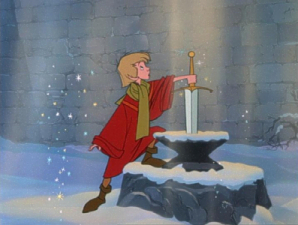
The Sweatbox Review:
First released in 1963, Walt Disney’s take on the young King Arthur tale, The Sword In The Stone, falls into late-period Walt, when the Studio had to make the animated films without the supervision he had shown to the early classics Snow White, Pinocchio, Fantasia or Bambi. By this time Walt’s preoccupation with DisneyLand (the park and the show), big live-action features such as Mary Poppins, and the EPCOT park project meant that he spent less and less time in the animation department, an expensive operation to run. “You know,” he once said jokingly to his animators, “with live action I can go out with the actors and film a scene in a day. You guys take six months!” Although this was true, Walt was always good to his artists and chose to cut costs in the animation division rather than scrap the very department that had built the company entirely. These cost-cutting methods primarily came in the form of the Xerox process of copying the animators’ drawings directly to cels, cutting the amount ink and paint staff previously needed considerably. The result shows the lines of the artists’ pencils much more clearly and lent a new sense of “life” to characters, although Walt took some time to warm to this look of his productions.

Primarily developed for 101 Dalmatians to aid the depiction of hundreds of spotty dogs, the Studio did produce some classic films in this period. Dalmatians introduced the sketchier technique and this was a good choice of story to begin this new Disney style with, as its contemporary feel was well suited to the rough edged animation style and the angular, block-colored backgrounds created for the film. The Xerox process also contributed heavily to the free-wheeling, loose feel of The Jungle Book, while the look also helped give the Winnie The Pooh films a defined style – something that the computer aided systems of today have some trouble in replicating. Somewhere in the middle of all of this was The Sword In The Stone, an often underrated Disney picture that is all too seldom seen and usually released to home video as part of a package of titles that get lost under the weight of whichever lead title the Studio is pushing at the time.
Perhaps one of the main reasons why The Sword In The Stone does fail to slot into the “classic” features made by Walt Disney is because of its animation style. While Sleeping Beauty was created with the lush storybook-come-to-life feel that audiences had come to expect from a Disney film, it was still a box-office failure and led to the cost cutting in the animation department. The new style fit Dalmatians like a glove, but here the story calls for more of a recall of that fairy-tale quality, with its themes of royalty and magic. Given the rougher style of design, the screenwriters went with a more comically enhanced script, and so the otherwise awesome Merlin becomes a nitwit blundering wizard, and Mim never rises to being a true villainess.
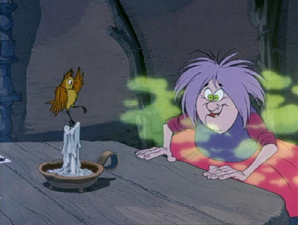
The story does not actually have a central villain at all, apart from Wart’s own situations, and so there is no central arc or final incentive for protagonist or antagonist to aspire to. As a result, it’s easy to see how the Studio got into the rut of their next few films being very episodic in structure. There is no real thread that runs through The Sword In The Stone, as the story wanders from encounter to encounter, ultimately ending up at the title’s stone, from which the sword must be drawn. It comes very late into the movie, by which time the audience may well wonder why the film has been given its name at all. When it does finally come, the moment is portrayed very well, although again it seems that writers were stumped at how to top such a momentous occasion with any kind of climax, as the film winds up within minutes of this happening.
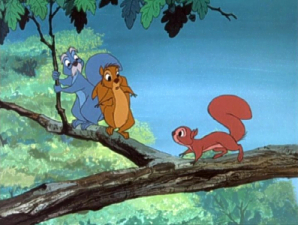
One could say that the whole point of the film is exactly this: that all of Wart’s lessons has been provided to him in order to arrive at this end, to become the man he must be to lead the kingdom, and once this event has transpired, what would be added by any extra running time? However, the lessons brought forward for Wart to learn do not seem to result in anything; the poor boy is never given the chance to do anything with the knowledge he has acquired. Even in the celebrated Wizard’s Duel, a clip that has been seen countless times in Disney compilation specials, Wart stands by helpless while Merlin steps in to save him from Mim.
The Sword In The Stone was the first Disney picture that owed all of its directorial vision to one man: Wolfgang “Woolie” Reitherman, who would continue to fashion the Studio’s animated output well after Walt’s death in 1966. As such, perhaps the team spirit that helped gel the previous Disney outings failed to materialise, with each part of the Studio carrying work out on their own particular section of the film independently. The few songs, by the Sherman Brothers, are, except for Mad Madam Mim, rarely included in any soundtrack compilation sets, although they all have a bouncy rhythm and Higitus Figitus uses the word play that helped establish the Shermans at the Studio and led to the Supercalifragilisticexpialidocious tongue twisters of Mary Poppins and United Artists’ Chitty Chitty Bang Bang.
The rest of the soundtrack is the usual mixture of American and English voices that always seems to work in animation, and each compliment their roles nicely. Disney fans can have a field day listening out for the many talents involved as many of them were either veterans or future voices for other characters: Wart (Rickie Sorenson) was part voiced by Wolfgang’s sons Richard and Robert (who also contributed to Winnie The Pooh and The Jungle Book); Archimedes, Merlin’s talking owl, was Junius Matthews, later to become Rabbit in the Pooh films, while Sir Ector was vocalized by Sebastian Cabot, also doubling as the narrator, and another future Pooh performer (again as the story-teller) and of The Jungle Book (as Bagheera).

The story lends itself well to the Disney treatment (by Bill Peet), with its themes of magic and wizardry, and there are many memorable moments, but as a whole it just seems to lack the classic touch. Animation wise, it is fine and the backgrounds display good detail and continuity, although there is some recycling of material from Sleeping Beauty, both visually and musically, but given the irreverent tone, this is possibly an in-joke (the ending also bears a similarity with 1992’s Aladdin, when Merlin returns from the future in a loud Hawaiian shirt). One does wonder what direction the film would have taken if it had been animated in the 40s or 50s, when Walt first bought the rights and was in the middle of perfecting the animated art form, but in any event The Sword In The Stone does stand up as a faithful translation of White’s book.
Is This Thing Loaded?
Finally The Sword In The Stone has been given the attention it deserves, and it’s in the extras department where this Gold Collection DVD impresses and surprises. Not seen as one of Walt’s truly classic endeavors (mainly due to the reasons highlighted above), Disney has actually given the movie a fine treatment on disc, with some fascinating extras!
When the disc plays for the first time, the usual sneak peeks run (although these can be avoided by selecting the Menu key on your remote). This disc features trailers for the Snow White Platinum Edition, Hunchback 2, 102 Dalmatians (live-action) and a great preview for The Emperor’s New Groove, all accessible again on the main menu. The menus for this release are well done, and while not the fully animated 3D extravaganzas seen on Tarzan or Atlantis, do provide the right mood. The menu changes are fun too!
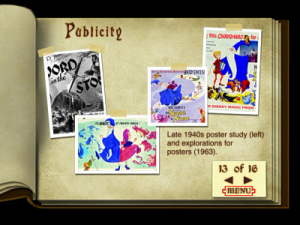
In the Bonus Features section you’ll find The Sword In The Stone Scrapbook, a collection of concept, production and still art from the making of the movie. The character designs show how Wart and Merlin evolved, and there are also some great poster treatments (including one from the 1940s when the film was originally intended to be made, and when it was promoted as “an amazing story of action and adventure”). Rounding out this section is a re-issue poster, and a selection of images from the DisneyLand theme park incarnations of the film.
Film Facts is a brief series of text pages outlining White’s original story and its journey to the screen via Disney. A couple of Sing-along Songs, Higitus Figitus and That’s What Makes The World Go Round, are also viewable and may even be of interest to more older fans as they highlight the Shermans’ great lyrics.

The brothers Sherman appear once again in a new retrospective interview documentary, The Magic Key: Music Magic. Here Richard and Robert Sherman explain their involvement in The Sword In The Stone (their first animated picture) and how they came to write the songs for the movie. Running around eight minutes, this is a great piece, similar to their accounts of working on Bedknobs And Broomsticks on that film’s DVD, featuring more concept art, storyboard sequences and, best of all, the brothers playing through a couple of songs from the movie, including two deleted songs, Old Oak Tree and The Magic Key, from earlier abandoned versions!
Even better is the inclusion of a full edition of the television show Walt Disney Presents! This episode, titled All About Magic, first aired in 1957 and is a typical of-the-time look at magical conventions and traditions. The show starts off with Walt himself hosting and performing a few magic tricks of his own (and looking like he had a fine time doing them as well!) before taking us down to the Studio magic prop room and handing over to the Magic Mirror (Hans Conreid in a role he would often recreate for TV) from Snow White. In its originally as broadcast black and white, the show has not benefited from any restoration, but looks as how one would expect, with only a few scratches, and a clean soundtrack. Included within the show are the animated shorts Magician Mickey, Trick Or Treat, and a lengthy Bibbidi-Bobbidi-Boo sequence from Cinderella, but a fair deal of this particular program is made up of original material, with some nice animation touches and a lot more of Walt that we usually get in the television specials!
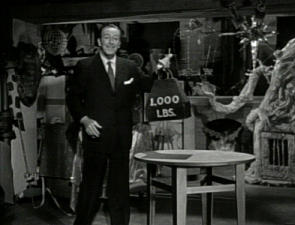
More animated shorts are included on the disc itself (this time in their original full color and with main and end title cards). Knight For A Day is a favorite Goofy cartoon of mine, and compliments the main feature well, with its modern spin on the jousting matches of old. The link between the feature and the 1938 Mickey Mouse cartoon The Brave Little Tailor seems to be only that it is set in olden times, though it is a great cartoon, with some of the best animation of Mickey in the 30s and was rewarded with an Oscar nomination for Best Short.
For what might be considered a “secondary release”, the material here displays a well thought out choice, and there is nothing missing that is available in other regional editions (including the European SE) – a very good selection, though as an earlier Gold Collection title, this disc fails to include any DVD-ROM additions.
Case Study:
Following on from VHS tradition, and the Gold Collection DVDs come house in traditionally Disney white keepcases. The cover art presents a rather striking and dramatic image on the front as opposed to the more generic picture used in previous and international issues of the film. Initial pressings came with a savings coupon booklet and a catalog of current Disney DVD releases, while all copies should include a double-sided insert covering the chapter stops on one side and an overview of the scrapbook feature on the other.
Ink And Paint:
Previously released in a deluxe CAV LaserDisc edition, both discs announced that the film had been modified to fit standard TV screens. This is totally inaccurate, as The Sword In The Stone was shot to a 1.37:1 negative, which is essentially the same ratio as presented here – there is nothing missing in the image. As was the case with many films in the early 60s, it would have been cropped in some theaters to create a widescreen ratio look, and it is likely Sword In The Stone was masked to 1.75:1 (much like the recent Disney films are shot at 1.66:1 and cropped slightly to 1.85 for theatrical screening).

What is a slight disappointment is that the film has not been given the all-digital cleanup that the other features have received, with the print on show the same master as from the CAV laser edition. Not that there’s anything wrong with it, save for a very few nicks and scratches, and this is definitely a more recently remastered print than the earliest tape editions, but it’s not a complete restoration. Colors are accurate though, and the general quality does nothing to detract from the knockabout nature and rough style of the film itself.
Scratch Tracks:
The CAV LaserDisc introduced a “new” stereo mix of The Sword In The Stone, that had actually been created at the time of the film’s original release but not widely used. The LD track was fairly warm, with some depth to the sound and a few surround surprises thrown in. This DVD claims a 5.1 remix, but I couldn’t really make out any discernible difference from the CAV laser. However, everything was present and correct on that track and the stereo effects do have quite a nice spatial separation in them. Dialogue was recorded cleanly and makes for good reproduction here, as with the French and Spanish tracks also offered. In addition, an English subtitle track can be selected.
Final Cut:
While not widely seen as one of Disney’s best, The Sword In The Stone is in fact a very enjoyable picture, and although none of the characters went on to much success outside of the film (Merlin is perhaps the most well-known figure in the movie, with his nose apparently based on Walt’s own!), it did inspire a short-lived Sword Ceremony attraction at DisneyLand. Opening on Christmas Day 1963, The Sword In The Stone may not rate as highly on many critics’ lists as some of Walt’s greater achievements, but remains an entertaining curiosity for fans and newcomers alike, falling well into the tradition of the recent comedy Disney features such as Aladdin and The Emperor’s New Groove. It’s also an essential addition, of course, for those who wish to complete their Disney DVD collections!
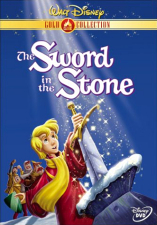 | ||
 [1] [1] |
- [Image]: http://www.amazon.com/Sword-Stone-Disney-Classic-Collection/dp/B00004R9A0?tag2=animatedviews-20
Source URL: https://animatedviews.com/2003/the-sword-in-the-stone-gold-classic-collection/